Economics Assignment: Market Analysis, Elasticity, and Fiscal Policy
VerifiedAdded on 2023/06/10
|11
|1657
|456
Homework Assignment
AI Summary
This economics assignment provides an analysis of various economic concepts and policies. Part 1 presents multiple-choice questions covering topics like firm behavior, monopolies, perfect competition, GDP, and monetary policy. Part 2 delves into more in-depth answers. Answer 1 examines the effects of rent control on the property market, including excess demand and potential black markets. Answer 2 analyzes the short-run and long-run effects of a cost-saving technology in a perfectly competitive agricultural market. Answer 3 calculates and interprets the price elasticity of demand for ice cream, exploring the implications for revenue. Answer 4 discusses contractionary monetary policy and its application by the Reserve Bank of Australia. Finally, Answer 5 covers expansionary fiscal policy, including government expenditure, and its impact on aggregate demand. The assignment concludes with a reference and bibliography.
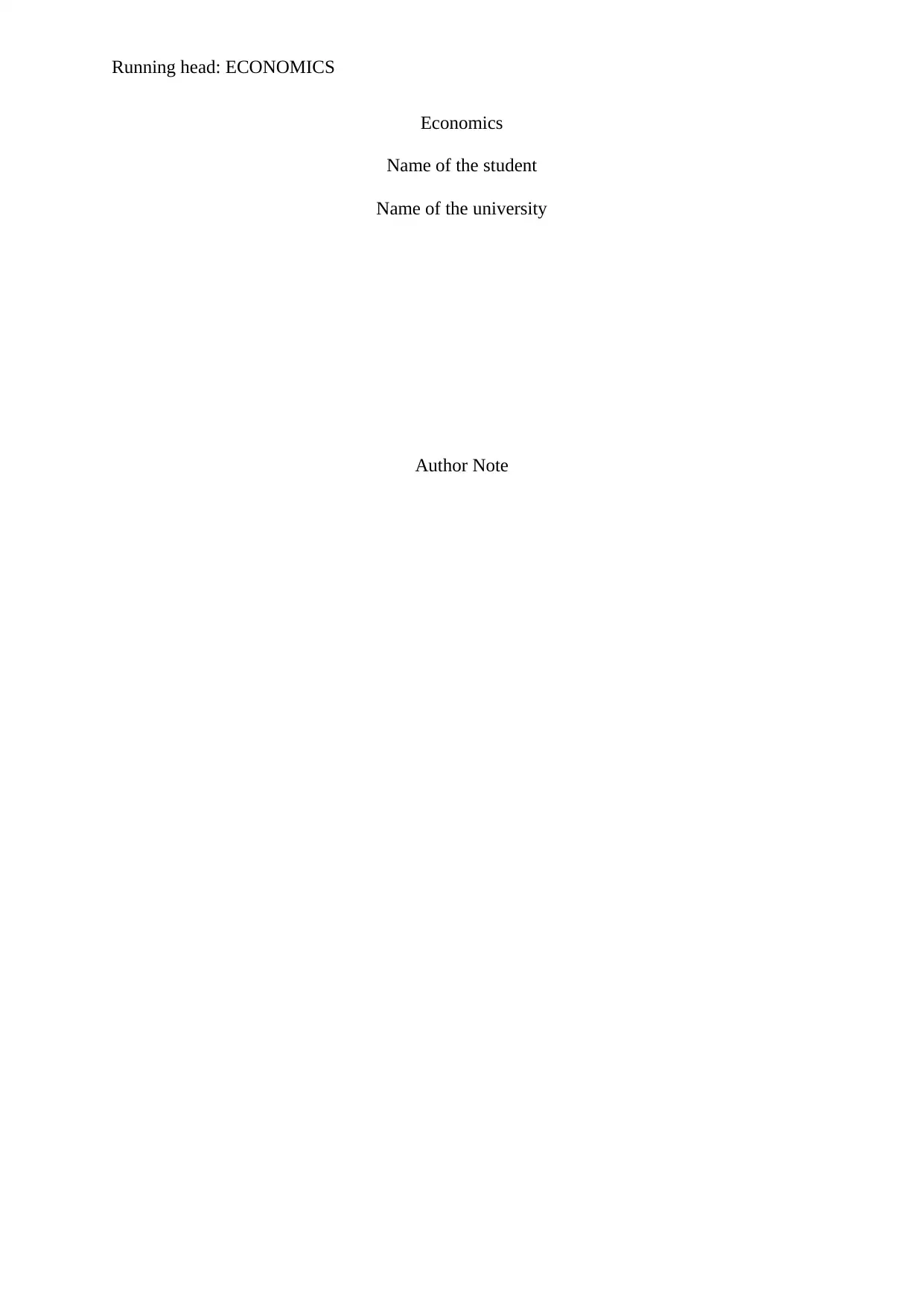
Running head: ECONOMICS
Economics
Name of the student
Name of the university
Author Note
Economics
Name of the student
Name of the university
Author Note
Paraphrase This Document
Need a fresh take? Get an instant paraphrase of this document with our AI Paraphraser
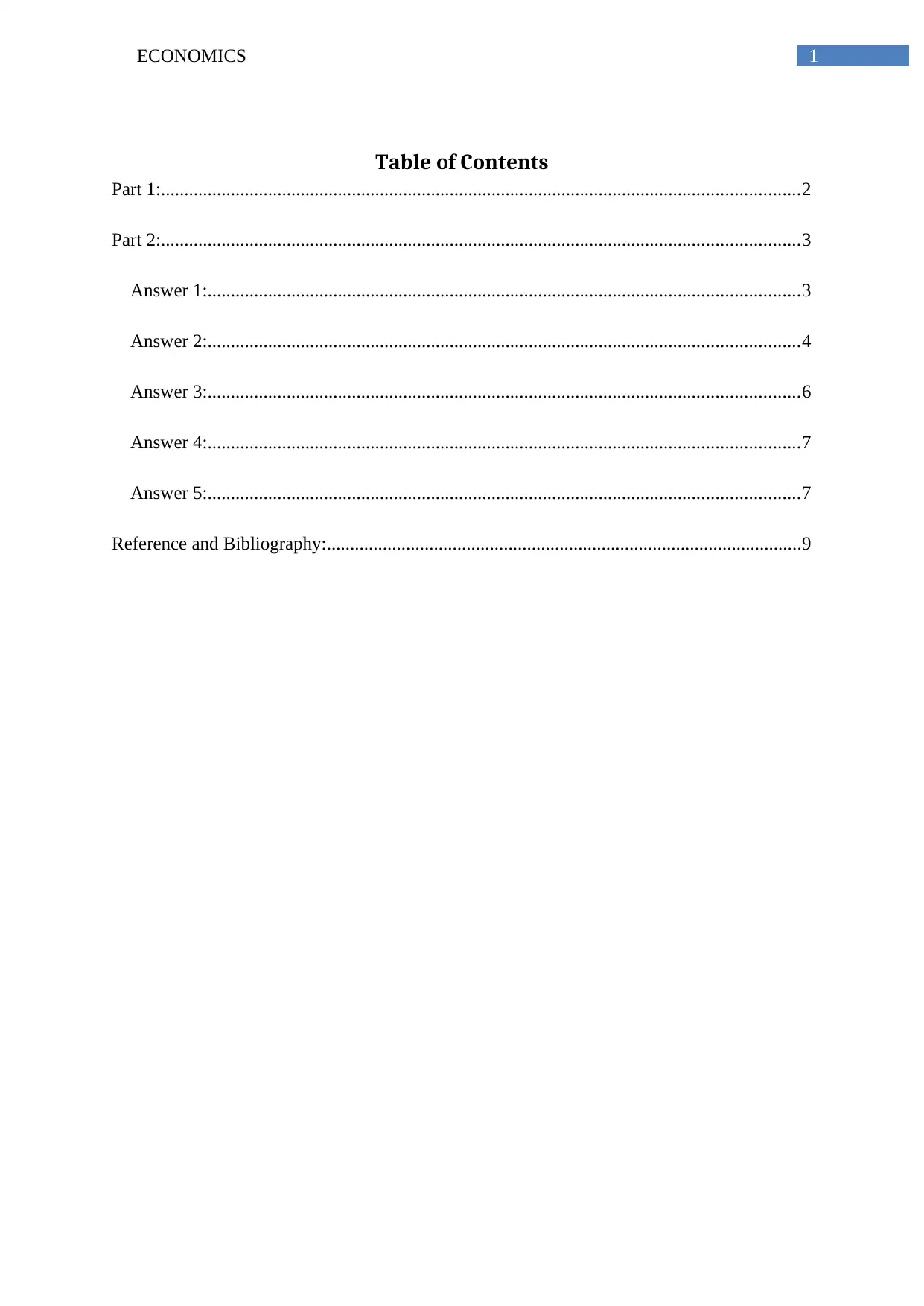
1ECONOMICS
Table of Contents
Part 1:.........................................................................................................................................2
Part 2:.........................................................................................................................................3
Answer 1:...............................................................................................................................3
Answer 2:...............................................................................................................................4
Answer 3:...............................................................................................................................6
Answer 4:...............................................................................................................................7
Answer 5:...............................................................................................................................7
Reference and Bibliography:......................................................................................................9
Table of Contents
Part 1:.........................................................................................................................................2
Part 2:.........................................................................................................................................3
Answer 1:...............................................................................................................................3
Answer 2:...............................................................................................................................4
Answer 3:...............................................................................................................................6
Answer 4:...............................................................................................................................7
Answer 5:...............................................................................................................................7
Reference and Bibliography:......................................................................................................9
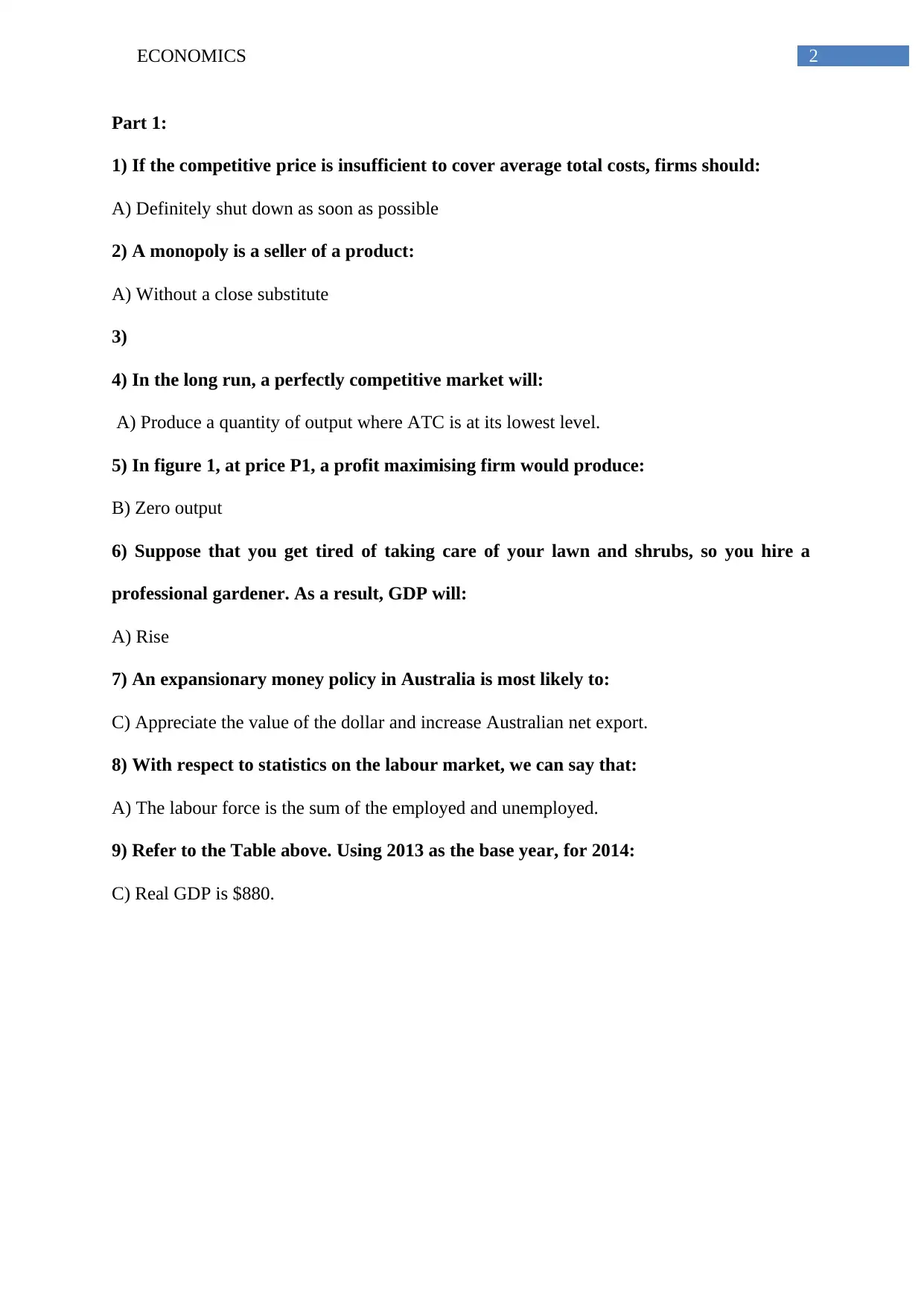
2ECONOMICS
Part 1:
1) If the competitive price is insufficient to cover average total costs, firms should:
A) Definitely shut down as soon as possible
2) A monopoly is a seller of a product:
A) Without a close substitute
3)
4) In the long run, a perfectly competitive market will:
A) Produce a quantity of output where ATC is at its lowest level.
5) In figure 1, at price P1, a profit maximising firm would produce:
B) Zero output
6) Suppose that you get tired of taking care of your lawn and shrubs, so you hire a
professional gardener. As a result, GDP will:
A) Rise
7) An expansionary money policy in Australia is most likely to:
C) Appreciate the value of the dollar and increase Australian net export.
8) With respect to statistics on the labour market, we can say that:
A) The labour force is the sum of the employed and unemployed.
9) Refer to the Table above. Using 2013 as the base year, for 2014:
C) Real GDP is $880.
Part 1:
1) If the competitive price is insufficient to cover average total costs, firms should:
A) Definitely shut down as soon as possible
2) A monopoly is a seller of a product:
A) Without a close substitute
3)
4) In the long run, a perfectly competitive market will:
A) Produce a quantity of output where ATC is at its lowest level.
5) In figure 1, at price P1, a profit maximising firm would produce:
B) Zero output
6) Suppose that you get tired of taking care of your lawn and shrubs, so you hire a
professional gardener. As a result, GDP will:
A) Rise
7) An expansionary money policy in Australia is most likely to:
C) Appreciate the value of the dollar and increase Australian net export.
8) With respect to statistics on the labour market, we can say that:
A) The labour force is the sum of the employed and unemployed.
9) Refer to the Table above. Using 2013 as the base year, for 2014:
C) Real GDP is $880.
⊘ This is a preview!⊘
Do you want full access?
Subscribe today to unlock all pages.

Trusted by 1+ million students worldwide
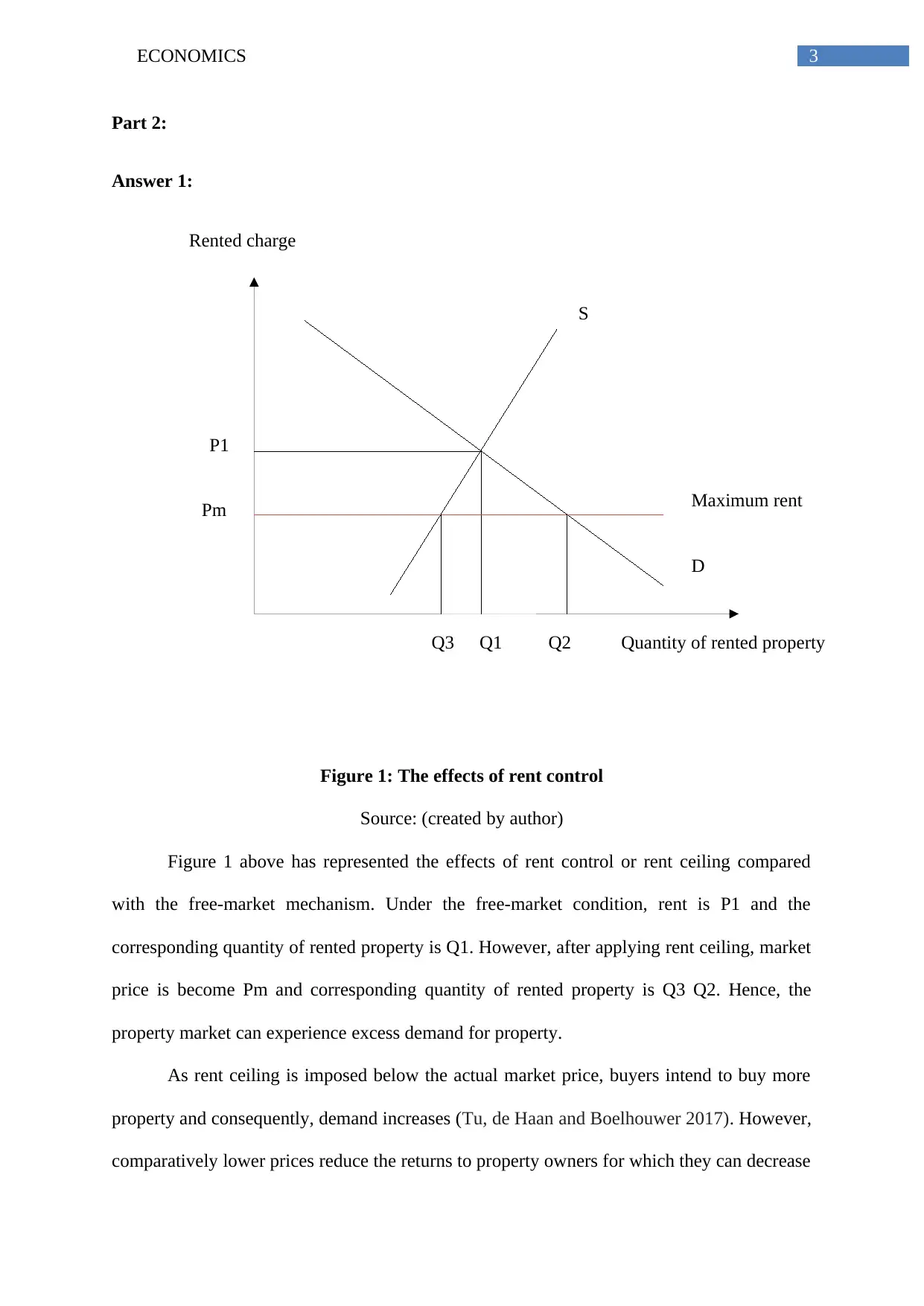
3ECONOMICS
P1
Pm
Q1Q3 Q2
S
D
Quantity of rented property
Rented charge
Maximum rent
Part 2:
Answer 1:
Figure 1: The effects of rent control
Source: (created by author)
Figure 1 above has represented the effects of rent control or rent ceiling compared
with the free-market mechanism. Under the free-market condition, rent is P1 and the
corresponding quantity of rented property is Q1. However, after applying rent ceiling, market
price is become Pm and corresponding quantity of rented property is Q3 Q2. Hence, the
property market can experience excess demand for property.
As rent ceiling is imposed below the actual market price, buyers intend to buy more
property and consequently, demand increases (Tu, de Haan and Boelhouwer 2017). However,
comparatively lower prices reduce the returns to property owners for which they can decrease
P1
Pm
Q1Q3 Q2
S
D
Quantity of rented property
Rented charge
Maximum rent
Part 2:
Answer 1:
Figure 1: The effects of rent control
Source: (created by author)
Figure 1 above has represented the effects of rent control or rent ceiling compared
with the free-market mechanism. Under the free-market condition, rent is P1 and the
corresponding quantity of rented property is Q1. However, after applying rent ceiling, market
price is become Pm and corresponding quantity of rented property is Q3 Q2. Hence, the
property market can experience excess demand for property.
As rent ceiling is imposed below the actual market price, buyers intend to buy more
property and consequently, demand increases (Tu, de Haan and Boelhouwer 2017). However,
comparatively lower prices reduce the returns to property owners for which they can decrease
Paraphrase This Document
Need a fresh take? Get an instant paraphrase of this document with our AI Paraphraser
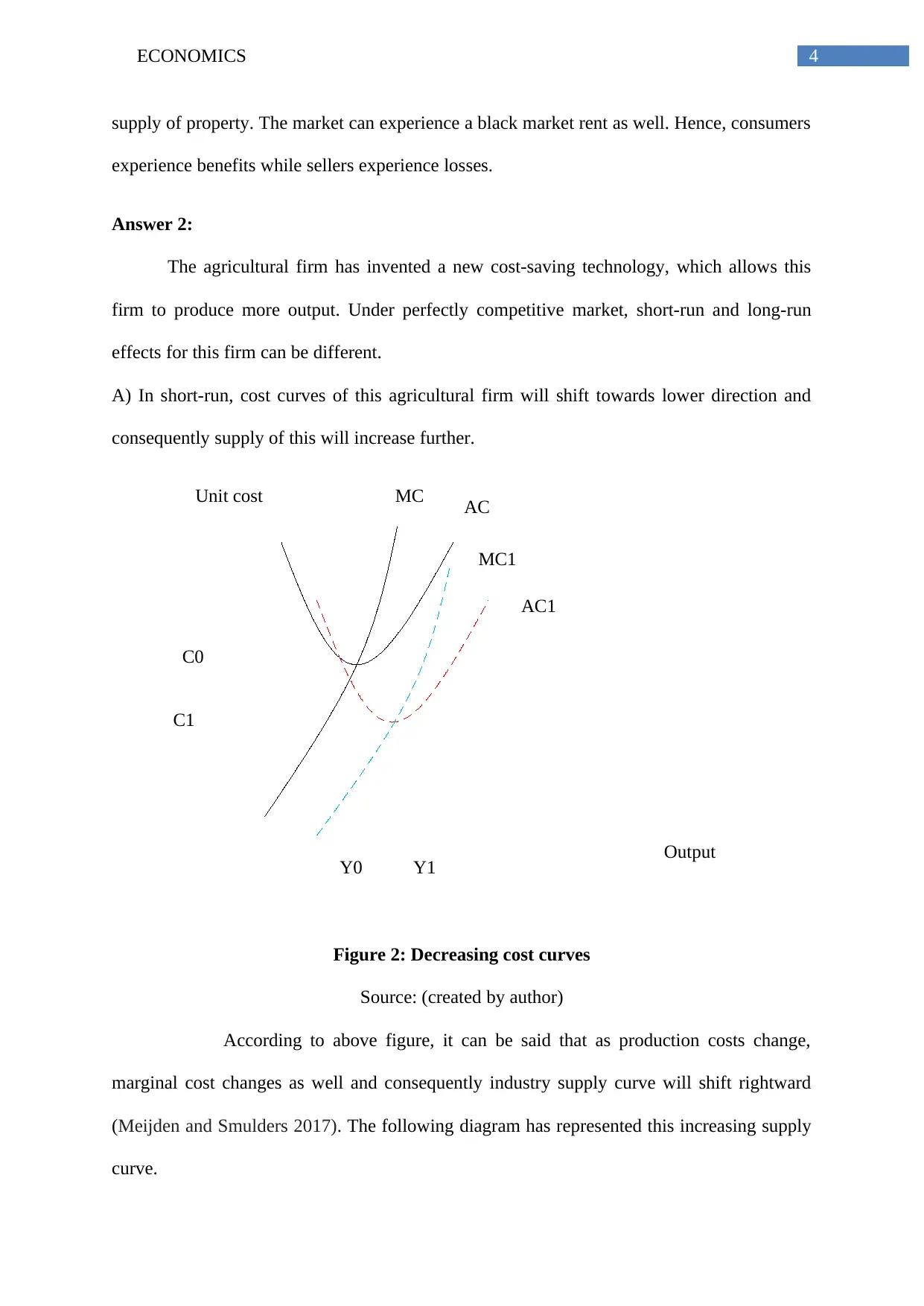
4ECONOMICS
Output
Unit cost
C0
C1
AC
MC
AC1
MC1
Y0 Y1
supply of property. The market can experience a black market rent as well. Hence, consumers
experience benefits while sellers experience losses.
Answer 2:
The agricultural firm has invented a new cost-saving technology, which allows this
firm to produce more output. Under perfectly competitive market, short-run and long-run
effects for this firm can be different.
A) In short-run, cost curves of this agricultural firm will shift towards lower direction and
consequently supply of this will increase further.
Figure 2: Decreasing cost curves
Source: (created by author)
According to above figure, it can be said that as production costs change,
marginal cost changes as well and consequently industry supply curve will shift rightward
(Meijden and Smulders 2017). The following diagram has represented this increasing supply
curve.
Output
Unit cost
C0
C1
AC
MC
AC1
MC1
Y0 Y1
supply of property. The market can experience a black market rent as well. Hence, consumers
experience benefits while sellers experience losses.
Answer 2:
The agricultural firm has invented a new cost-saving technology, which allows this
firm to produce more output. Under perfectly competitive market, short-run and long-run
effects for this firm can be different.
A) In short-run, cost curves of this agricultural firm will shift towards lower direction and
consequently supply of this will increase further.
Figure 2: Decreasing cost curves
Source: (created by author)
According to above figure, it can be said that as production costs change,
marginal cost changes as well and consequently industry supply curve will shift rightward
(Meijden and Smulders 2017). The following diagram has represented this increasing supply
curve.
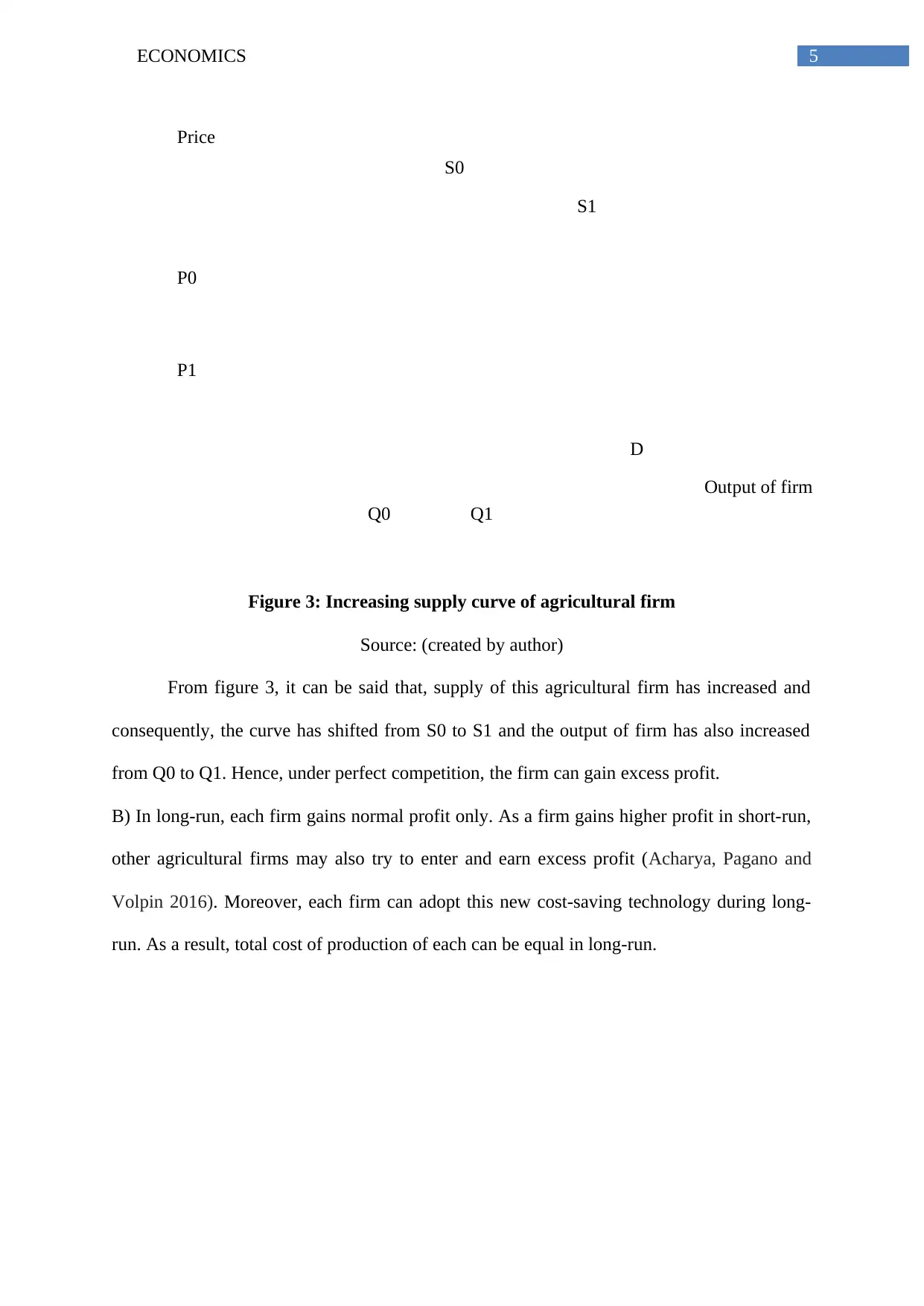
5ECONOMICS
D
S0
S1
Price
Output of firm
P0
P1
Q0 Q1
Figure 3: Increasing supply curve of agricultural firm
Source: (created by author)
From figure 3, it can be said that, supply of this agricultural firm has increased and
consequently, the curve has shifted from S0 to S1 and the output of firm has also increased
from Q0 to Q1. Hence, under perfect competition, the firm can gain excess profit.
B) In long-run, each firm gains normal profit only. As a firm gains higher profit in short-run,
other agricultural firms may also try to enter and earn excess profit (Acharya, Pagano and
Volpin 2016). Moreover, each firm can adopt this new cost-saving technology during long-
run. As a result, total cost of production of each can be equal in long-run.
D
S0
S1
Price
Output of firm
P0
P1
Q0 Q1
Figure 3: Increasing supply curve of agricultural firm
Source: (created by author)
From figure 3, it can be said that, supply of this agricultural firm has increased and
consequently, the curve has shifted from S0 to S1 and the output of firm has also increased
from Q0 to Q1. Hence, under perfect competition, the firm can gain excess profit.
B) In long-run, each firm gains normal profit only. As a firm gains higher profit in short-run,
other agricultural firms may also try to enter and earn excess profit (Acharya, Pagano and
Volpin 2016). Moreover, each firm can adopt this new cost-saving technology during long-
run. As a result, total cost of production of each can be equal in long-run.
⊘ This is a preview!⊘
Do you want full access?
Subscribe today to unlock all pages.

Trusted by 1+ million students worldwide
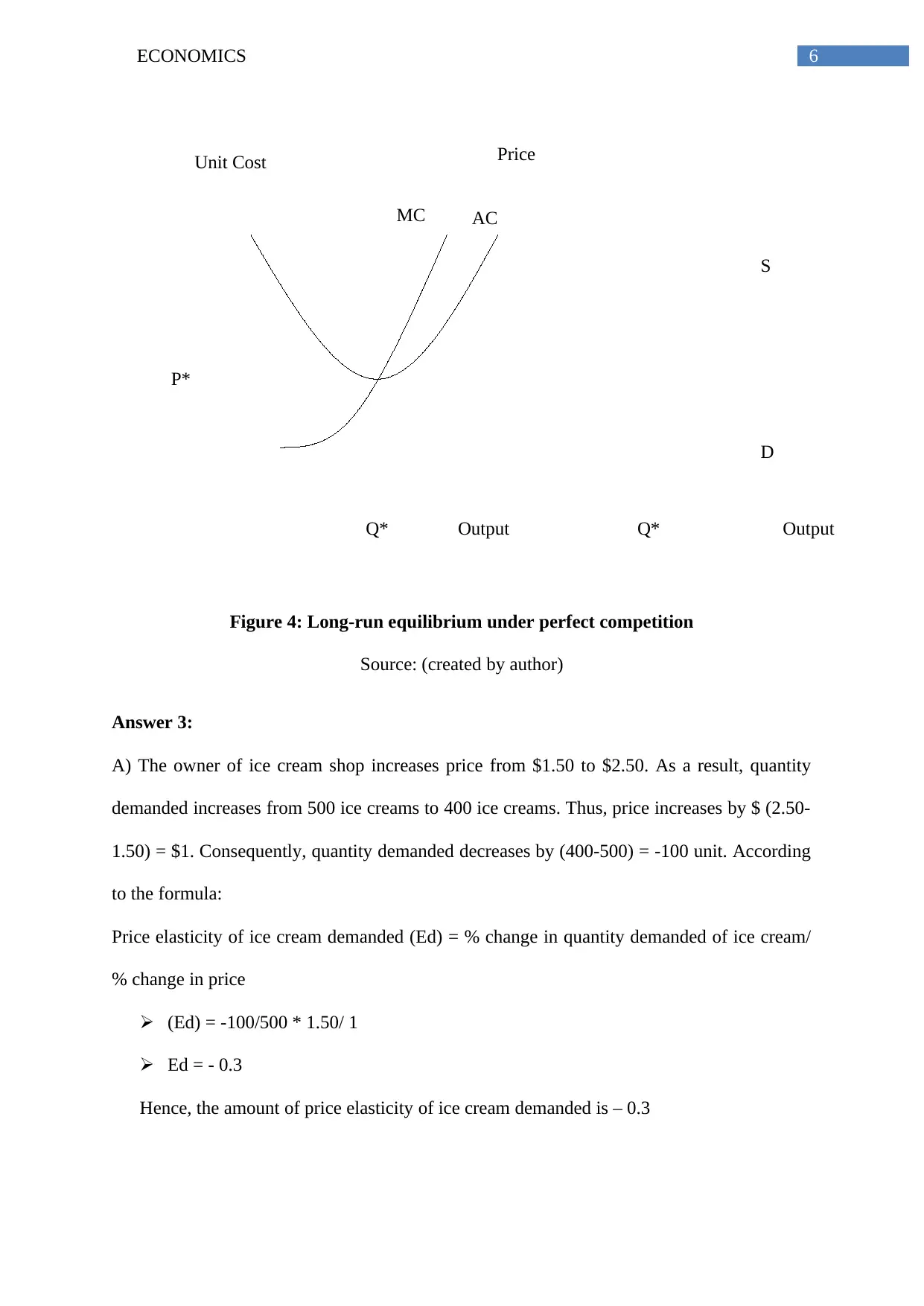
6ECONOMICS
PriceUnit Cost
P*
S
D
ACMC
Output OutputQ* Q*
Figure 4: Long-run equilibrium under perfect competition
Source: (created by author)
Answer 3:
A) The owner of ice cream shop increases price from $1.50 to $2.50. As a result, quantity
demanded increases from 500 ice creams to 400 ice creams. Thus, price increases by $ (2.50-
1.50) = $1. Consequently, quantity demanded decreases by (400-500) = -100 unit. According
to the formula:
Price elasticity of ice cream demanded (Ed) = % change in quantity demanded of ice cream/
% change in price
(Ed) = -100/500 * 1.50/ 1
Ed = - 0.3
Hence, the amount of price elasticity of ice cream demanded is – 0.3
PriceUnit Cost
P*
S
D
ACMC
Output OutputQ* Q*
Figure 4: Long-run equilibrium under perfect competition
Source: (created by author)
Answer 3:
A) The owner of ice cream shop increases price from $1.50 to $2.50. As a result, quantity
demanded increases from 500 ice creams to 400 ice creams. Thus, price increases by $ (2.50-
1.50) = $1. Consequently, quantity demanded decreases by (400-500) = -100 unit. According
to the formula:
Price elasticity of ice cream demanded (Ed) = % change in quantity demanded of ice cream/
% change in price
(Ed) = -100/500 * 1.50/ 1
Ed = - 0.3
Hence, the amount of price elasticity of ice cream demanded is – 0.3
Paraphrase This Document
Need a fresh take? Get an instant paraphrase of this document with our AI Paraphraser
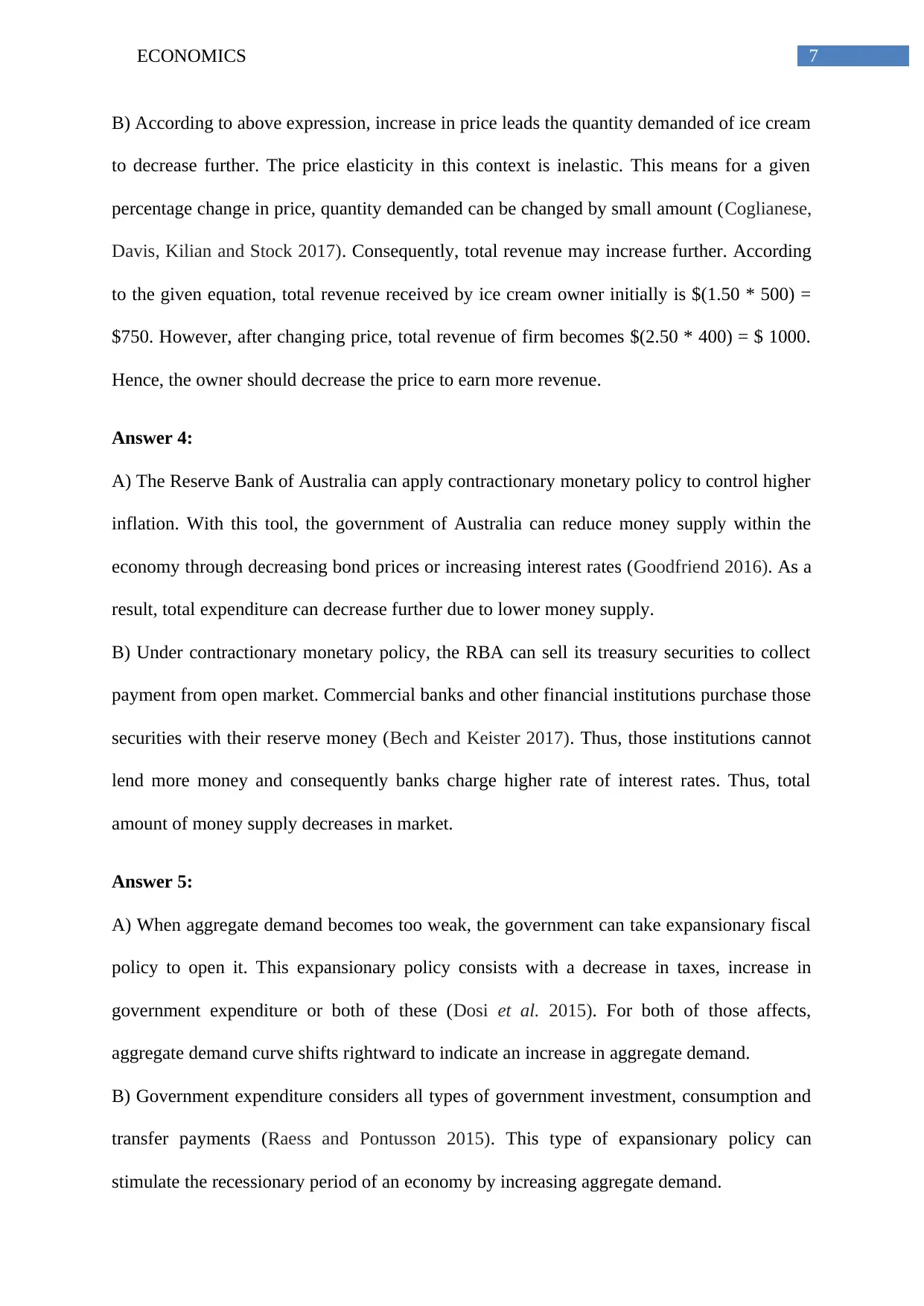
7ECONOMICS
B) According to above expression, increase in price leads the quantity demanded of ice cream
to decrease further. The price elasticity in this context is inelastic. This means for a given
percentage change in price, quantity demanded can be changed by small amount (Coglianese,
Davis, Kilian and Stock 2017). Consequently, total revenue may increase further. According
to the given equation, total revenue received by ice cream owner initially is $(1.50 * 500) =
$750. However, after changing price, total revenue of firm becomes $(2.50 * 400) = $ 1000.
Hence, the owner should decrease the price to earn more revenue.
Answer 4:
A) The Reserve Bank of Australia can apply contractionary monetary policy to control higher
inflation. With this tool, the government of Australia can reduce money supply within the
economy through decreasing bond prices or increasing interest rates (Goodfriend 2016). As a
result, total expenditure can decrease further due to lower money supply.
B) Under contractionary monetary policy, the RBA can sell its treasury securities to collect
payment from open market. Commercial banks and other financial institutions purchase those
securities with their reserve money (Bech and Keister 2017). Thus, those institutions cannot
lend more money and consequently banks charge higher rate of interest rates. Thus, total
amount of money supply decreases in market.
Answer 5:
A) When aggregate demand becomes too weak, the government can take expansionary fiscal
policy to open it. This expansionary policy consists with a decrease in taxes, increase in
government expenditure or both of these (Dosi et al. 2015). For both of those affects,
aggregate demand curve shifts rightward to indicate an increase in aggregate demand.
B) Government expenditure considers all types of government investment, consumption and
transfer payments (Raess and Pontusson 2015). This type of expansionary policy can
stimulate the recessionary period of an economy by increasing aggregate demand.
B) According to above expression, increase in price leads the quantity demanded of ice cream
to decrease further. The price elasticity in this context is inelastic. This means for a given
percentage change in price, quantity demanded can be changed by small amount (Coglianese,
Davis, Kilian and Stock 2017). Consequently, total revenue may increase further. According
to the given equation, total revenue received by ice cream owner initially is $(1.50 * 500) =
$750. However, after changing price, total revenue of firm becomes $(2.50 * 400) = $ 1000.
Hence, the owner should decrease the price to earn more revenue.
Answer 4:
A) The Reserve Bank of Australia can apply contractionary monetary policy to control higher
inflation. With this tool, the government of Australia can reduce money supply within the
economy through decreasing bond prices or increasing interest rates (Goodfriend 2016). As a
result, total expenditure can decrease further due to lower money supply.
B) Under contractionary monetary policy, the RBA can sell its treasury securities to collect
payment from open market. Commercial banks and other financial institutions purchase those
securities with their reserve money (Bech and Keister 2017). Thus, those institutions cannot
lend more money and consequently banks charge higher rate of interest rates. Thus, total
amount of money supply decreases in market.
Answer 5:
A) When aggregate demand becomes too weak, the government can take expansionary fiscal
policy to open it. This expansionary policy consists with a decrease in taxes, increase in
government expenditure or both of these (Dosi et al. 2015). For both of those affects,
aggregate demand curve shifts rightward to indicate an increase in aggregate demand.
B) Government expenditure considers all types of government investment, consumption and
transfer payments (Raess and Pontusson 2015). This type of expansionary policy can
stimulate the recessionary period of an economy by increasing aggregate demand.
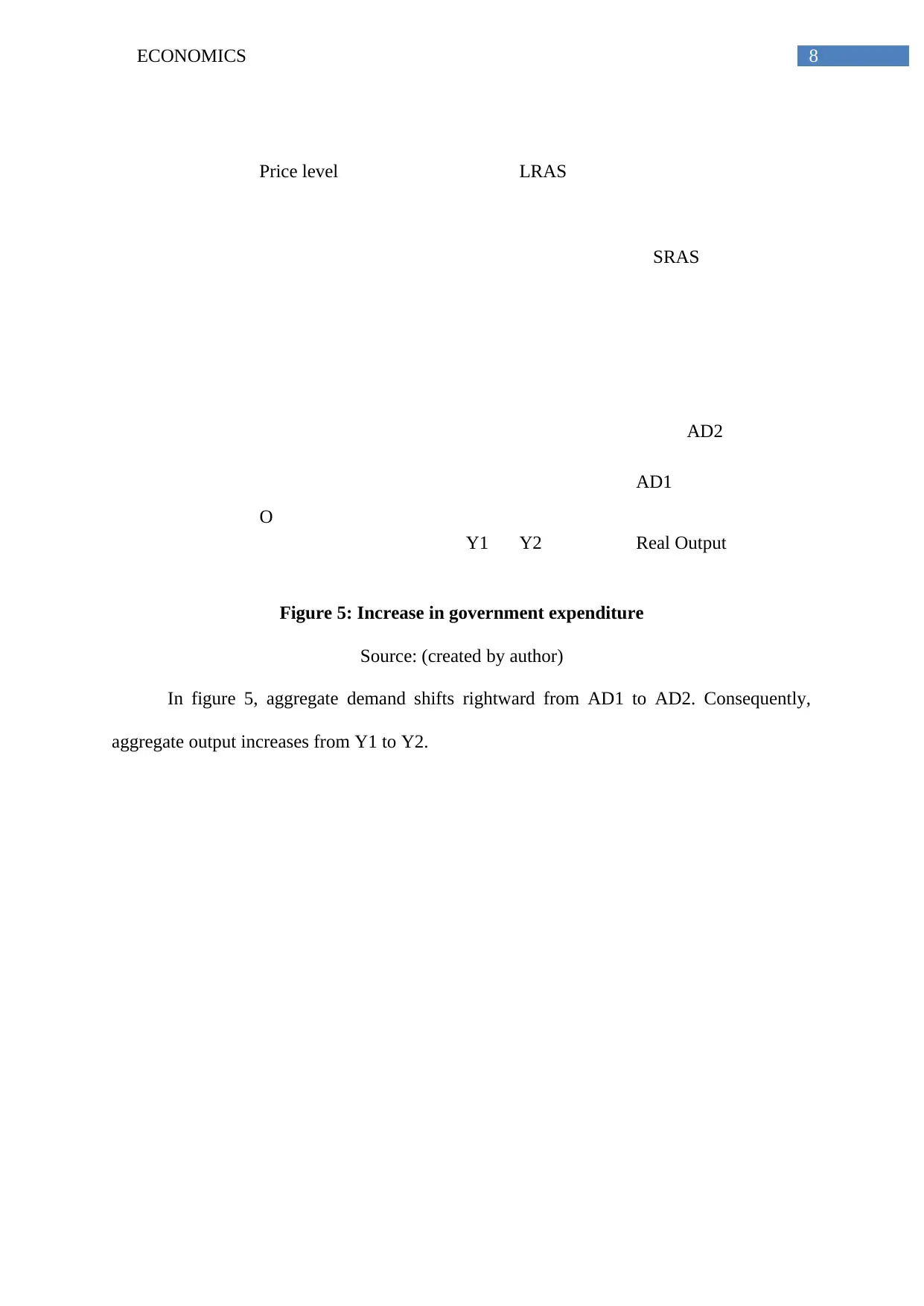
8ECONOMICS
AD1
AD2
SRAS
LRASPrice level
O
Real OutputY1 Y2
Figure 5: Increase in government expenditure
Source: (created by author)
In figure 5, aggregate demand shifts rightward from AD1 to AD2. Consequently,
aggregate output increases from Y1 to Y2.
AD1
AD2
SRAS
LRASPrice level
O
Real OutputY1 Y2
Figure 5: Increase in government expenditure
Source: (created by author)
In figure 5, aggregate demand shifts rightward from AD1 to AD2. Consequently,
aggregate output increases from Y1 to Y2.
⊘ This is a preview!⊘
Do you want full access?
Subscribe today to unlock all pages.

Trusted by 1+ million students worldwide
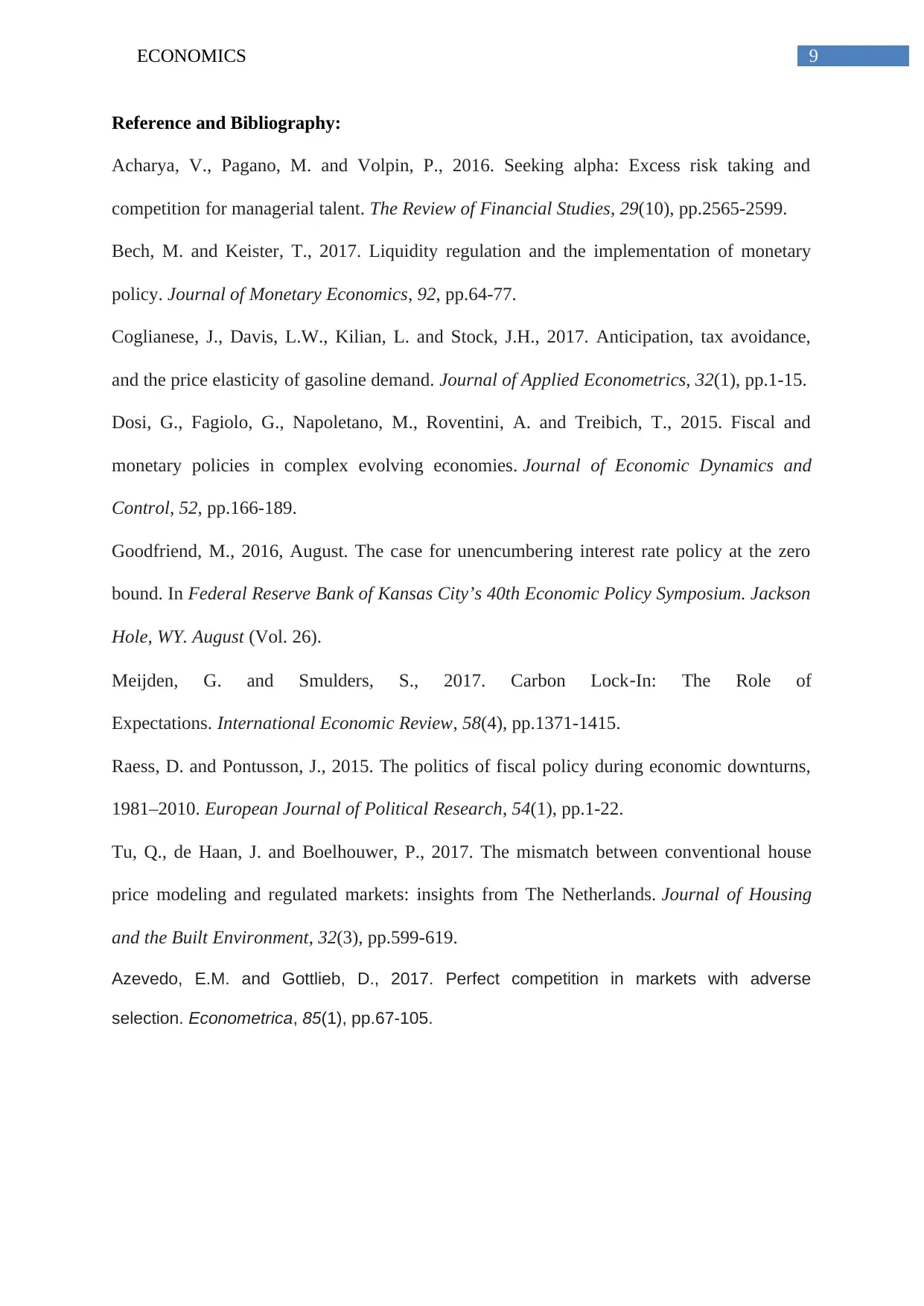
9ECONOMICS
Reference and Bibliography:
Acharya, V., Pagano, M. and Volpin, P., 2016. Seeking alpha: Excess risk taking and
competition for managerial talent. The Review of Financial Studies, 29(10), pp.2565-2599.
Bech, M. and Keister, T., 2017. Liquidity regulation and the implementation of monetary
policy. Journal of Monetary Economics, 92, pp.64-77.
Coglianese, J., Davis, L.W., Kilian, L. and Stock, J.H., 2017. Anticipation, tax avoidance,
and the price elasticity of gasoline demand. Journal of Applied Econometrics, 32(1), pp.1-15.
Dosi, G., Fagiolo, G., Napoletano, M., Roventini, A. and Treibich, T., 2015. Fiscal and
monetary policies in complex evolving economies. Journal of Economic Dynamics and
Control, 52, pp.166-189.
Goodfriend, M., 2016, August. The case for unencumbering interest rate policy at the zero
bound. In Federal Reserve Bank of Kansas City’s 40th Economic Policy Symposium. Jackson
Hole, WY. August (Vol. 26).
Meijden, G. and Smulders, S., 2017. Carbon Lock‐In: The Role of
Expectations. International Economic Review, 58(4), pp.1371-1415.
Raess, D. and Pontusson, J., 2015. The politics of fiscal policy during economic downturns,
1981–2010. European Journal of Political Research, 54(1), pp.1-22.
Tu, Q., de Haan, J. and Boelhouwer, P., 2017. The mismatch between conventional house
price modeling and regulated markets: insights from The Netherlands. Journal of Housing
and the Built Environment, 32(3), pp.599-619.
Azevedo, E.M. and Gottlieb, D., 2017. Perfect competition in markets with adverse
selection. Econometrica, 85(1), pp.67-105.
Reference and Bibliography:
Acharya, V., Pagano, M. and Volpin, P., 2016. Seeking alpha: Excess risk taking and
competition for managerial talent. The Review of Financial Studies, 29(10), pp.2565-2599.
Bech, M. and Keister, T., 2017. Liquidity regulation and the implementation of monetary
policy. Journal of Monetary Economics, 92, pp.64-77.
Coglianese, J., Davis, L.W., Kilian, L. and Stock, J.H., 2017. Anticipation, tax avoidance,
and the price elasticity of gasoline demand. Journal of Applied Econometrics, 32(1), pp.1-15.
Dosi, G., Fagiolo, G., Napoletano, M., Roventini, A. and Treibich, T., 2015. Fiscal and
monetary policies in complex evolving economies. Journal of Economic Dynamics and
Control, 52, pp.166-189.
Goodfriend, M., 2016, August. The case for unencumbering interest rate policy at the zero
bound. In Federal Reserve Bank of Kansas City’s 40th Economic Policy Symposium. Jackson
Hole, WY. August (Vol. 26).
Meijden, G. and Smulders, S., 2017. Carbon Lock‐In: The Role of
Expectations. International Economic Review, 58(4), pp.1371-1415.
Raess, D. and Pontusson, J., 2015. The politics of fiscal policy during economic downturns,
1981–2010. European Journal of Political Research, 54(1), pp.1-22.
Tu, Q., de Haan, J. and Boelhouwer, P., 2017. The mismatch between conventional house
price modeling and regulated markets: insights from The Netherlands. Journal of Housing
and the Built Environment, 32(3), pp.599-619.
Azevedo, E.M. and Gottlieb, D., 2017. Perfect competition in markets with adverse
selection. Econometrica, 85(1), pp.67-105.
Paraphrase This Document
Need a fresh take? Get an instant paraphrase of this document with our AI Paraphraser

10ECONOMICS
1 out of 11
Related Documents
Your All-in-One AI-Powered Toolkit for Academic Success.
+13062052269
info@desklib.com
Available 24*7 on WhatsApp / Email
![[object Object]](/_next/static/media/star-bottom.7253800d.svg)
Unlock your academic potential
Copyright © 2020–2025 A2Z Services. All Rights Reserved. Developed and managed by ZUCOL.





